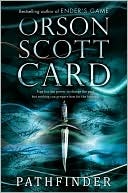Pathfinder by O. S. Card
DOI:
https://doi.org/10.20361/G2301ZAbstract
Card, Orson S. Pathfinder. New York: Simon Pulse, 2010. Print.
Two warnings are in order before you read the first line. It is long (657 pages) and just the first in a series. Warnings are offered because the story is so completely engrossing that your sense of time will be altered. While you are in the story, time will speed up or slow down with the pace of the story and you will want to linger in some passages to figure out what is going on but speed through others to find out what will happen. When you are away from the story, your sole thought will be how to get back to it. Hours will pass in seeming minutes and minutes will linger for hours. And, as you approach the last few pages with the disappointment that comes when a great story ends but the satisfaction that all the loose ends will be tied up, a twist gets thrown in to make you desperate for the story to continue.
These are the likely reactions for those who love science-fiction fantasy stories set in a future that is more like the past, with multiple story lines that converge and diverge, and characters who discover they have abilities that seem far-fetched yet somehow possible if only we knew a few secrets and had the will-power to practice them.
This is a story about time travel and intrigue where people are not simply good or bad; in fact, each character is both with the ultimate judgment falling on the reader. The typeface splits the novel into two strands. In one, Ram and the expendables control a spaceship filled with sleeping human colonists that “make a daring leap into theoretical physics” to colonize another earth-like planet. The jump into the fold creates nineteen ships moving backward (yet forward) through time. In the other strand, thirteen-year-old Rigg is thrust from his life in the forest with his father’s dying order for him to find his mother and sister using a bag of nineteen jewels and the name of a banker in the city. Along the way, Rigg collects a trusty band of companions to help him. As expected, they have many adventures which are quite unexpected even for readers of similar novels. Fortunately, all that seemingly useless education from his father in the forest turns out to be very useful after all.
The writing is fantastic without a word out of place, the characters are believable whether they are youths or adults, and the author is a master of creating new worlds and new words that are readily understandable. I saw hints of many favourite fantasy/science fiction/historic future adventure stories: Harry Potter, the Hobbit, Hitchhiker’s Guide to the Galaxy, and of course, Orson Scott Card’s own series starting with Ender’s Game. It would be impossible to put an appropriate age on this book as it can be enjoyed (or not) at many different levels – the writing is probably understandable for some starting in grade 5; the cover says “12 and up.”
Highly recommended: 4 out of 4 stars
Reviewer: David Sulz
David is a librarian at the University of Alberta working mostly with scholars in Economics, Religious Studies, and Social Work. His university studies included: Library Studies, History, Elementary Education, Japanese, and Economics. On the education front, he taught various grades and subjects for several years in schools as well as museums. His interest in Japan and things Japanese stands above his other diverse interests.

Published
How to Cite
Issue
Section
License
Authors who publish with this journal agree to the following terms:
- Authors retain copyright and grant the journal right of first publication with the work simultaneously licensed under a Creative Commons Attribution License that allows others to share the work with an acknowledgement of the work's authorship and initial publication in this journal.
- Authors are able to enter into separate, additional contractual arrangements for the non-exclusive distribution of the journal's published version of the work (e.g., post it to an institutional repository or publish it in a book), with an acknowledgement of its initial publication in this journal.
- Authors are permitted and encouraged to post their work online (e.g., in institutional repositories or on their website) prior to and during the submission process, as it can lead to productive exchanges, as well as earlier and greater citation of published work (See The Effect of Open Access).






